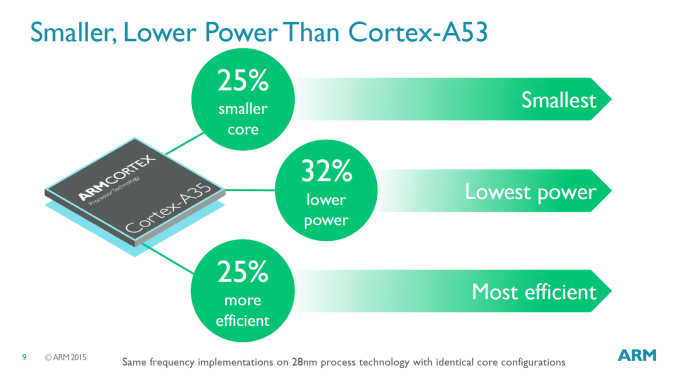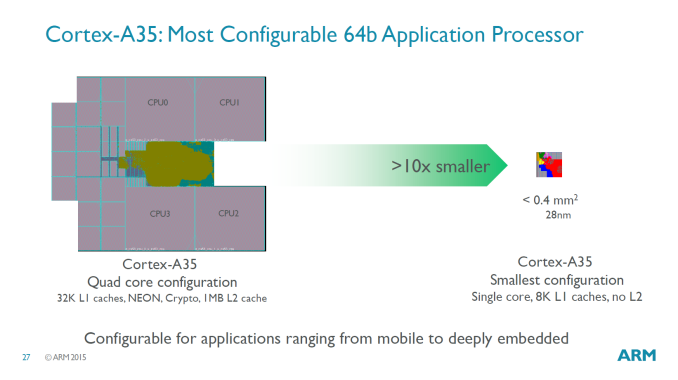http://www.anandtech.com/show/9769/arm-announces-cortex-a35 
28 nm lithography is still low cost king, for cost reasons and for fastest build time to product (lots of assembly lines available).
ARM has done another smart core replacement, giving significant speed and power consumption bonuses while allowing the old chip base and ball grid (and the old phone motherboard designs) to be completely reused. Smart, but they have done that before, regularly, on the low end of things.
This is a product that can SCALE DOWN VERY WELL, running at 28nm, 20nm, 16nm, 14nm
and below when that gets here.
Since it can pick up a 25-35% performance boost over the old 32 bit A-7, that puts it in the rough lower half of the performance ballpark where the 64 bit A-53 is sitting today.
 The old A-53 is likely going to get an overhaul next, as it is the oldest 64 bit chipset anybody is still actually using
The old A-53 is likely going to get an overhaul next, as it is the oldest 64 bit chipset anybody is still actually using (the oldest, the old A-57 has already been upgraded and replaced by the A-72).
If you think you see three constantly upgraded "matched and paired" levels of ARM 64 bit cores churning in turn to support a Mediatek style triple layer processor, you are right. BTW, 32 bit ARM is dead, as of this release. It will drag on, zombie-like for a year or so, but it is dead right now with a Cortex A-35 ".35 caliber" sized hole in its forehead.
Android is in its
second full 64 bit generation now, with the third generation coming out next year. 32 bit is pretty much totally past tense in Android land at this point.
One also has to question if Intel is functionally dead again as well, since they have nothing low cost competitive in phone space any more, especially since Asus has dropped them from the Zenphone 2.
And also please remember, Win 10 mobile is now a MS controlled "for our own Qualcomm processor based Lumina products only" proposition right now. No Intel phones anywhere ..... got some Intel based tablets still, though, still left over from last year's big push.
Now that ARM has announced all the various A-35, A-53, A-72 layers, Mediatek can come out of the closet about what they are really actually using now, correctly naming them instead of saying they are using "two levels of A-53 cores" like they have been saying.
Once again, ARM has delayed putting their cards face up on the table until the partner built products are actually ready to ship.  How powerful is this tiny quad core A-53 as shown?
How powerful is this tiny quad core A-53 as shown? It is 25% better than my current A-7 based cell phone is right now and it would have better graphics and longer battery life as well -- a step up in every aspect.
And as physically tiny as the new A-35 cores are, a 8-10 core A-35 chipset at 14/16nm will fit in the space that was required for the oldest Cortex A-7 48nm lithography quad core chip designs. Remember, if we are re-using the old 48nm chipbase and ball grid array on purpose on the low end cheapie phones so there is lots & lots of room on top of that chip base for some serious A-35 power expansion should the vendor want to go do that.
Also please realize that when using lower modern lithography levels, dual cores of this thing is are physically as small as the current crop of IoT cores, with far far greater capabilities.
A bluetooth phone in your glasses or split between your ear rings is now completely possible using 14nm. Google Glass will get a new look at, again, by both the Google and Samsung glass design teams.

